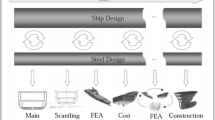Abstract
Classification societies cannot cover the torsional strength assessment with simple empirical formula as the size of a containership increases drastically over 10 000 TEU in recent years. Torsional strength of a container ship is very difficult to estimate with an analytical method due to its alternatively varying cross sections, i. e. an open and a closed section. This article proposes an approach to construct a simplified FE model using a 3D compartment model available from the beginning of ship design process. The model is cut to pieces of lots of small pieces of lines by a set of transverse, longitudinal and horizontal planes. Two algorithms are developed for mesh generation of internal structures; one for assembling the broken lines into closed loops and the other for automatically generating mesh from the loops. Another algorithm is proposed to generate mesh for outer hull using outermost nodes of the FE model built for internal members. The validity of the simplified model is discussed along with a beam theory based approach in J Mar Sci Technol (2008)
Similar content being viewed by others
References
Owen SJ (1998) A survey of unstructured mesh generation technology. Proceedings of the seventh international mesh round aable. Dearborn, Michigan, pp 239–267
Chae S-W, Jeong J-H (1997) Unstructured surface meshing using operators. Proceedings of the sixth international mesh round table. Park City, Utah, pp 281–291
Talbert JA, Parkinson AR (1990) Development of an automatic, two dimensional finite element mesh generation using quadrilateral elements and bezier curve boundary definition. Int J Numer Meth Eng 29:1551–1567
Beahmann PL, Wittchen SL, Shephard MS, Grice KR, Yerry MA (1987) Robust geometrically based, automatic two-dimensional mesh generation. Int J Numer Meth Eng 24:1043–1078
Armstrong CG, Tam T (1991) 2D finite element mesh generation by medial axis subdivision. Adv Eng Softw 13:313–324
Joe B (1995) Quadrilateral mesh generation in polygonal regions. Comput Aided Design 7:209–222
Blacker TD, Stephenson MB (1991) Paving: a new approach to automated quadrilateral mesh generation. Int J Numer Meth Eng 32:811–847
Owen SJ, Staten ML, Canann SA, Saigal S (1999) Q-Morph: an indirect approach to advancing front quad meshing. Int J Numer Meth Eng 44:1317–1340
Lee K-Y, Kim I-I, Cho D-Y, Kim T-W (2003) An Algorithm of Automatic 2D Quadrilateral Mesh Generation with Line Constraints. Comput Aided Design 35:1055–1068
Jensen PS (1990) Automatic panel generation for seakeeping and wave resistance calculations. CFD and CAD in ship design, Elsevier, pp. 133–146
Yoon T-K, Kim D-J (1997) Automatic mesh generation of curved hull surface. Transaction of Korea Committee for Ocean Resources and Engineering 11(2):1055–1068
Kwon J-C, Kang H-Y, Huh O-J, Kim J-S (2001) CAD/CAE interface and auto-mesh generation fro ship structure. Proceedings of Korean Society of CAD/CAM Engineers
Jang B-S, Suh Y-S, Kim E-K, Lee T-H (2008) Automatic FE modeler using stiffer based mesh generation algorithm for ship structural analysis. Mar Struct (in press)
Kim I-I (2006) A development of data structure and mesh generation algorithm for global ship analysis modeling system. Adv Eng Softw 37(2):85–96
http://www.napa.fi, Home page of NAPA
Jang B-S, Jung J-H, Suh Y-S (2008) Use of 3D compartment model for simplified full ship FE model. Part II: validation of simplified FE model. J Mar Sci Technol (in press)
Author information
Authors and Affiliations
Corresponding author
About this article
Cite this article
Jang, BS., Jung, JH. & Suh, YS. Use of 3D compartment model for simplified full ship FE model. Part I: construction of FE model. J Mar Sci Technol 13, 154–163 (2008). https://doi.org/10.1007/s00773-008-0274-0
Received:
Accepted:
Published:
Issue Date:
DOI: https://doi.org/10.1007/s00773-008-0274-0




